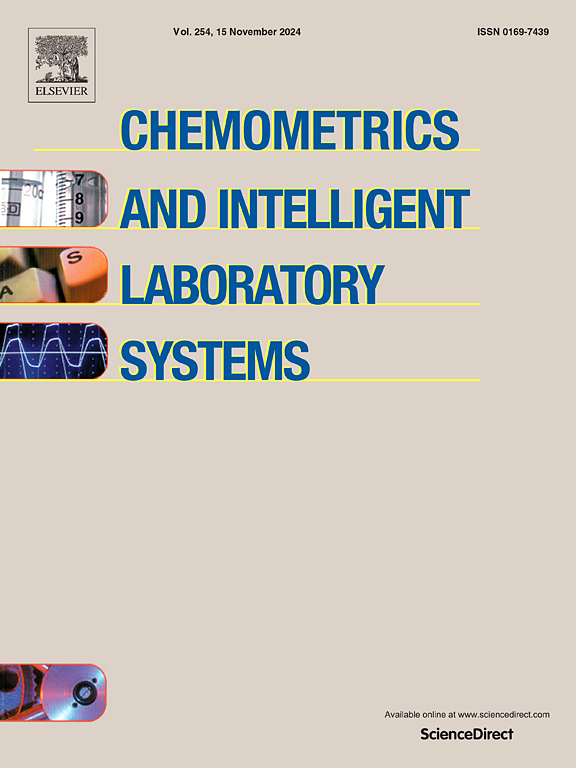偏最小二乘回归中增强数据点重要性的子集选择:与Kennard-Stone方法的比较研究
IF 3.8
2区 化学
Q2 AUTOMATION & CONTROL SYSTEMS
Chemometrics and Intelligent Laboratory Systems
Pub Date : 2025-04-25
DOI:10.1016/j.chemolab.2025.105416
引用次数: 0
摘要
在多变量数据分析中,选择具有代表性的样本子集对于建立准确的预测模型至关重要。本研究评估了增强数据点重要性(EDPI)方法在子集选择中的应用,并将其性能与广泛使用的Kennard-Stone算法进行了比较。EDPI方法使用DPI和分层凸包方法对所有数据点进行排序,从而根据数据集中的重要性对数据点进行排序,其中最重要的点信息量最大。这两种方法分别应用于两个不同的数据集,并为每个子集开发了偏最小二乘回归(PLSR)模型来评估预测性能。EDPI方法在不同的样本量上表现出与Kennard-Stone方法相当的性能。EDPI-PLS模型在样本较少的情况下获得了较低的预测均方根误差(RMSEP)值,表明该方法有效地选择了子集,并且该方法不太倾向于选择数据集中的影响点。此外,运行时间分析突出了EDPI方法的计算效率,特别是在高维数据集上。这些发现表明,EDPI是样本子集选择的一种鲁棒性和信息性策略,在预测准确性和计算效率方面具有优势。本文章由计算机程序翻译,如有差异,请以英文原文为准。
Enhanced data point importance for subset selection in partial least squares regression: A comparative study with Kennard-Stone method
In multivariate data analysis, the selection of representative subsets of samples is crucial for developing accurate predictive models. This study evaluates the application of the Enhanced Data Point Importance (EDPI) method for subset selection, comparing its performance with the widely-used Kennard-Stone algorithm. The EDPI method ranks all the data points using the DPI and layered convex hull approach, resulting in a ranked sequence of points based on their importance in the dataset, with the most important point being the most informative. Both methods were applied to two distinct datasets, and Partial Least Squares Regression (PLSR) models were developed for each subset to assess predictive performance. The EDPI method demonstrated comparable performance to the Kennard-Stone method across various sample sizes. The EDPI-PLS models achieved lower Root Mean Square Error of Prediction (RMSEP) values with fewer samples, indicating efficient subset selection, and the method is less inclined to select the influential points in the dataset. Moreover, the running time analysis highlighted the computational efficiency of the EDPI method, especially in high-dimensional datasets. These findings suggest that EDPI is a robust and informative strategy for sample subset selection, offering advantages in predictive accuracy and computational efficiency.
求助全文
通过发布文献求助,成功后即可免费获取论文全文。
去求助
来源期刊
CiteScore
7.50
自引率
7.70%
发文量
169
审稿时长
3.4 months
期刊介绍:
Chemometrics and Intelligent Laboratory Systems publishes original research papers, short communications, reviews, tutorials and Original Software Publications reporting on development of novel statistical, mathematical, or computer techniques in Chemistry and related disciplines.
Chemometrics is the chemical discipline that uses mathematical and statistical methods to design or select optimal procedures and experiments, and to provide maximum chemical information by analysing chemical data.
The journal deals with the following topics:
1) Development of new statistical, mathematical and chemometrical methods for Chemistry and related fields (Environmental Chemistry, Biochemistry, Toxicology, System Biology, -Omics, etc.)
2) Novel applications of chemometrics to all branches of Chemistry and related fields (typical domains of interest are: process data analysis, experimental design, data mining, signal processing, supervised modelling, decision making, robust statistics, mixture analysis, multivariate calibration etc.) Routine applications of established chemometrical techniques will not be considered.
3) Development of new software that provides novel tools or truly advances the use of chemometrical methods.
4) Well characterized data sets to test performance for the new methods and software.
The journal complies with International Committee of Medical Journal Editors'' Uniform requirements for manuscripts.

 求助内容:
求助内容: 应助结果提醒方式:
应助结果提醒方式:


